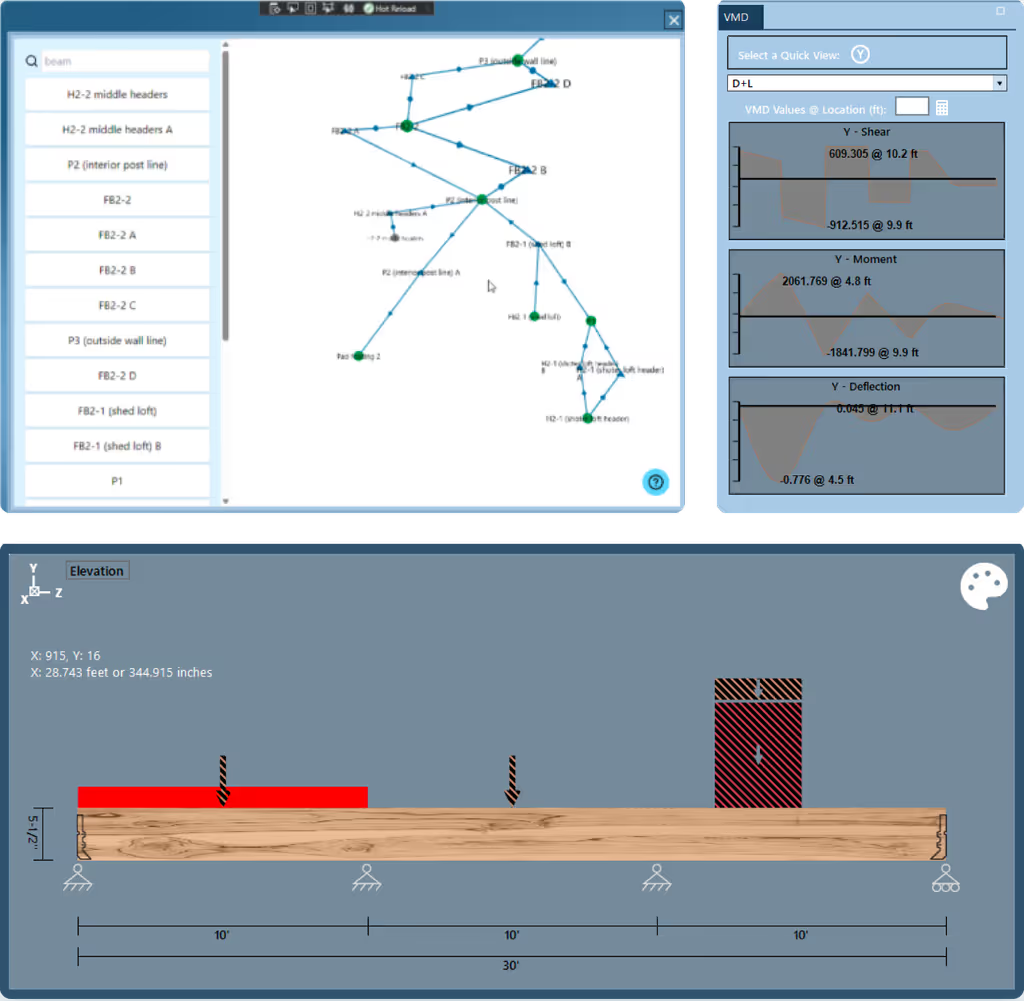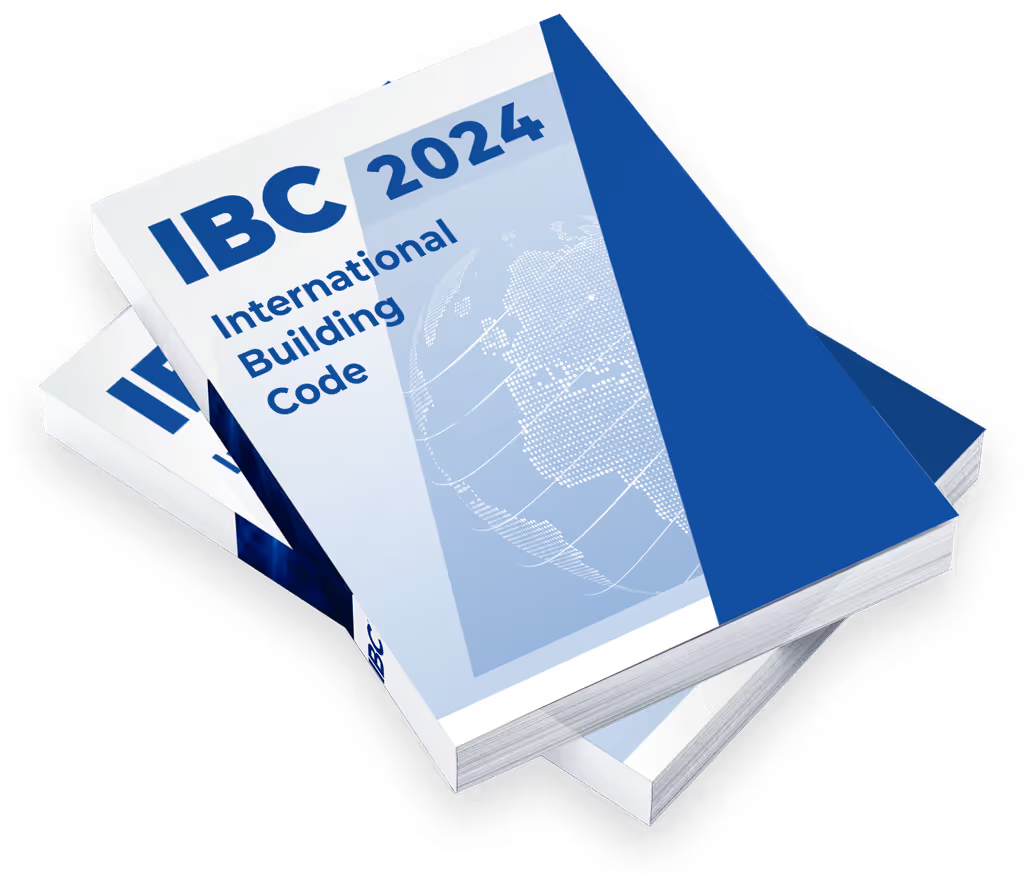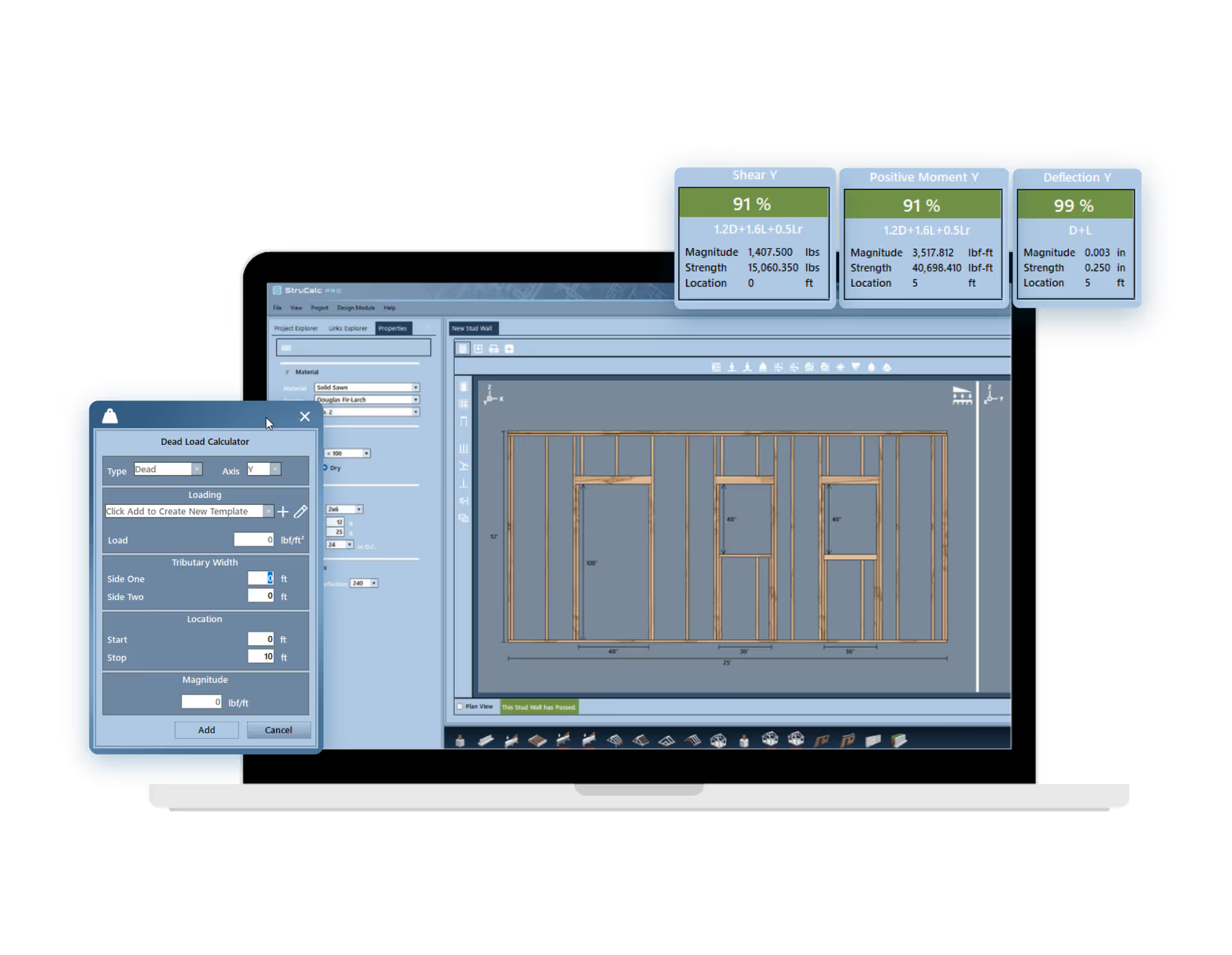Beam & Column Calculations Made Simple
Structural engineers, architects, and construction professionals rely on accurate calculations to ensure the integrity and safety of their designs. StruCalc offers a comprehensive and user-friendly solution for beam calcs, streamlining the process while maximizing accuracy, efficiency, and compliance with IBC and NDS codes.

Building Materials Supported

Wood

Steel

LVL & Glulam

Masonry

Concrete
Advanced Calculations & Reliable Insights
Analysis Capabilities
Multi-Span Beams
Cantilever Beams
Triaxial Loading
Dynamic Load Linking
English & Metric Units
Auto Sizing
ASD & LRFD

Checks & Outputs
Normal Stress
Shear Stress
Moment of Inertia
Buckling
Moment Capacity
Deflection
Reactions

Start saving time and stay focused on what matters.
Get your free 30 day trial today.
Beam Calculator FAQs
What Types of Beam Loads and Beam Analysis Does StruCalc Support?
Beams play a crucial role in structural integrity, distributing loads and ensuring stability. Beam load calculators must account for multiple factors, including:
- Point Loads and Distributed Loads – Forces applied at single points versus evenly spread loads.
- Dead Loads and Live Loads – Permanent structural weight versus variable loads from occupants, furniture, or environmental conditions.
- Shear Forces and Bending Moments – Critical factors in beam design to prevent structural failure.
- Deflection Limits – Ensuring beams do not exceed acceptable flexing limits per IBC and NDS standards.
What Structural Building Materials Does StruCalc Support?
Each material has distinct properties affecting beam strength, stiffness, and load capacity:
- Wood Beams – Lightweight and easy to work with, governed by NDS specifications for allowable stress design.
- Steel Beams – High strength-to-weight ratio, commonly used in commercial structures.
- Concrete Beams – Often reinforced with steel rebar to improve tensile strength.
- LVL & Glulam Beams – Engineered wood products offering high strength and customizable dimensions.
- Masonry & Brick Beams – Often used in load-bearing walls and arched openings, these materials rely on compressive strength and require reinforcement for tensile loads.
How Are Calculations For Beam Loads and Column Loads Different?
Beams and columns serve different structural functions, yet both are fundamental to building integrity. The primary distinctions include:
- Beams: Designed to resist bending moments and shear forces while transferring loads horizontally to columns or walls. Governed by equations such as:
- Bending Stress:
- Shear Stress:
- Deflection Formula for Simply Supported Beams:
- Columns: Primarily resist axial compression forces and must be analyzed for buckling and slenderness effects. Critical equations include:
- Euler’s Buckling Load:
- Axial Stress:
- Interaction Equations for Combined Bending and Axial Load (Per AISC and NDS)
Columns are susceptible to different failure modes, including short column crushing failure and long column buckling failure, whereas beams are primarily analyzed for bending, shear, and deflection limits.
StruCalc enables engineers to analyze both beams and columns efficiently, offering automated checks for buckling, axial load capacities, and moment resistance to ensure safe and code-compliant designs.
What Are The Advantages of Software-Based Beam Calculations?
Manual beam calculations require a thorough understanding of structural mechanics, but even experienced engineers encounter difficulties due to the complexity of real-world applications. Some challenges include:
- Complex Load Combinations: Beams often experience multiple concurrent loads, such as dead loads, live loads, wind loads, and seismic forces. Each must be factored correctly, following the load combinations prescribed by the IBC (International Building Code).
- Multi-Span Analysis: Solving for bending moments and shear forces in continuous beams with multiple spans requires iterative methods, such as the Moment Distribution Method, which is tedious to perform by hand.
- Deflection and Vibration Calculations: Hand calculations for deflection involve cumbersome equations, especially for non-standard loading and support conditions. Vibration analysis for dynamic loads, such as foot traffic or machinery-induced vibrations, requires Fourier transforms and advanced dynamic response equations.
- Torsional Stability and Buckling: Lateral-torsional buckling (LTB) is a failure mode that is difficult to analyze manually, as it depends on the beam’s cross-section, lateral bracing conditions, and unbraced length. This typically requires solving differential equilibrium equations or using empirical formulas from the AISC Steel Construction Manual.
- Non-Uniform Cross-Sections: Beams with varying cross-sections or built-up members (e.g., flitched beams) require piecewise integration to determine moment of inertia changes along the length.
While manual calculations can provide approximations for simple structures, they become impractical for complex systems. StruCalc eliminates these challenges by handling triaxial loading, dynamic load linking, and multi-span beams with precision.
While spreadsheets can handle basic beam calcs, they lack:
- Dynamic Load Path Analysis – StruCalc links reactions between members for realistic load distribution.
- Automated Material Selection – Engineers can choose from an extensive material database.
- Built-In Code Compliance – Spreadsheets require manual code checks, increasing the risk of non-compliance.
- Multi-Span Beam Analysis – StruCalc’s multi-span beam solver enables quick analysis of complex spans.
- Cantilever Beam Considerations – Load distribution and deflection analysis are streamlined with cantilever beam calculation tools.
With automated member sizing, StruCalc selects the most efficient beam size based on input loads, saving engineers time while ensuring compliance with safety standards.
Do Beam Calculations Need to Meet IBC and NDS Standards?
Structural calculations must adhere to strict building codes to ensure safety, durability, and regulatory approval. Compliance with IBC (International Building Code) and NDS (National Design Specification for Wood Construction) is essential for engineers and architects designing load-bearing structures. Key considerations for code compliance include:
- Code-Compliant Load Combinations – The IBC specifies required load combinations, accounting for dead loads, live loads, wind, seismic, and snow loads. StruCalc automatically applies these factors based on standard design methodologies.
- Allowable Stress Design (ASD) & Load and Resistance Factor Design (LRFD) – Different design philosophies must be considered. StruCalc allows engineers to switch between ASD and LRFD, ensuring designs meet the latest standards.
- Material-Specific Design Standards – The NDS governs wood construction, while steel and concrete beams must comply with AISC (American Institute of Steel Construction) and ACI (American Concrete Institute) codes. StruCalc incorporates these provisions automatically.
- Deflection and Serviceability Limits – The IBC limits allowable deflections for beams based on span length and material type. StruCalc ensures deflection criteria are met, preventing excessive sagging and vibration.
- Seismic and Wind Load Considerations – Structures in high-seismic or hurricane-prone regions must adhere to stricter guidelines. StruCalc integrates wind and seismic load provisions from ASCE 7 (Minimum Design Loads and Associated Criteria for Buildings and Other Structures) to ensure safety and compliance.
- Permit-Ready Reports – Many jurisdictions require sealed engineering calculations for permit approval. StruCalc generates detailed, structured reports that comply with building department requirements, accelerating the approval process.
By automating these complex compliance requirements, StruCalc eliminates manual errors, reduces design time, and ensures IBC- and NDS-compliant structural solutions.
Structural Design Calculations Made Simple
Increase Your Productivity
Let StruCalc save you time on structural calculations and help you do more of what you do best.
Maximize Accuracy & Compliance
StruCalc delivers accurate calculations according to industry best practices that meet IBC and NDS code.
Streamline Permit Approval
Designed according to industry best practices, our detailed reports are purposefully structured to accelerate permit approvals.
Features that Our Customers Love
Linked Load Paths
Get dynamically updated results with linked load paths.
Comprehensive Material Database
From wood and laminates to concrete and steel, we’ve got you covered!
Relevant Codes & Standards
Compliant with the IBC and NDS, StruCalc keeps you up to date with latest code.
Automated Member Sizing
Simply input your loads and let StruCalc determine the most efficient size of your beam, footing, and more!
Quick Calcs
Use our pre-configured calculators to get quick calcs for hundreds of common applications
Design View
Streamlines the addition of loads through an intuitive data input screen, allowing for easy editing.
Powerful Solutions For Every Project
ENSURE YOUR ENGINEERING CALCULATIONS ARE FUTURE-PROOF
StruCalc Supports the 2024 IBC
StruCalc Plus and Pro have been updated to support the 2024 International Building Code standard to ensure that you stay up to code now and in the future.


Saving you time with
Quick Calculations & Permit Ready Reports
With a library of built-in use cases and a robust report generation engine, StruCalc gets you the answers you need quickly and gives permit reviewers the detail they’re looking for.
Powerful tools for complex analysis
Dynamically Track Linked Load Paths
When loads are changed, calculations are automatically updated, saving you time and accurately identifying issues. Let StruCalc do the heavy lifting for you!

Now Offering PDH Courses
Join our community to get great deals on quality PDH courses or get our StruCalc Pro with PDH annual subscription to get 15 PDH hours included with StruCalc Pro.

Why Choose StruCalc?
Fast, Intuitive User Interface
Our straight-forward UI is designed for efficiency, making complex structural calculations easy to navigate with minimal learning curve—so you can focus on design, not deciphering software.
Personalized Onboarding & One-On-One Support
When you need help getting started or expert advice on a complex application, our veteran team of support engineers are just a click or call away.
Extensive Application & Material Database
With hundreds of real-world use cases and a library of common construction materials, StruCalc provides everything you need in one powerful platform.
Pricing & feature comparison:
| Top-tier differences: |
StruCalc Pro: $89.97/mo |
ClearCalcs Pro: $119/mo |
ENERCALC: $199/mo |
|---|---|---|---|
| Personalized Onboarding | |||
| 1:1 Engineering Support | |||
| 2024 IBC | |||
| User Themes | |||
| Concrete Beams | |||
| Masonry Beams | |||
| Wood Shearwalls | |||
| 2024 NDS | |||
| 2021 IBC | |||
| 2018 IBC | |||
| 2018 NDS | |||
| Imperial Units | |||
| Concrete Columns | |||
| Metric Units | |||
| Steel | |||
| Solid Sawn | |||
| I-Joists | |||
| Glulams | |||
| Structural Composite | |||
| 24+ Load Combinations | |||
| LRFD | |||
| ASD | |||
| Beam & Joist Spans | |||
| Live & Dead Loads | |||
| Isolated Footings | |||
| Continuous Footings | |||
| Collar Ties | |||
| Embedded Posts | |||
| Hip & Valley Beams | |||
| Flitch Beam | |||
| Stud Walls | |||
| Wind, Snow, & Seismic Loads | |||
| Advanced Footing Loads | |||
| Out of Plane Loading | |||
| Multi-span Columns | |||
| Bearing Walls | |||
| Retaining Walls | |||
| Linked Load Tracking | |||
| Beam Analysis | |||
| Wall Analysis | |||
| Masonry Columns | |||
| Concrete Walls | |||
| Masonry Walls | |||
| Wood Hangers | |||
| Curved Glulams |
Packed with Features
Best pricing in the industry
No one else offers as many features as StruCalc. Get more for your money and join thousands of architects and engineers that have chosen StruCalc as their partner for structural calculation software.
The Importance of Accurate Beam Load Calculations
StruCalc’s beam solver provides calculators for various materials, including wood, concrete, LVL & Glulam, masonry, and steel. With features such as linked load paths, automated member sizing, and dynamic load linking, engineers can perform detailed structural analysis quickly, generate comprehensive reports, and simplify the permitting process. This article explores essential aspects of beam load calculations, design challenges, material considerations, and how StruCalc’s beam software optimizes the engineering workflow.
Get Started with StruCalc
For engineers and construction professionals, beam calculation software is an indispensable tool for accurate structural analysis. StruCalc’s beam solver simplifies complex calculations, ensuring safety, compliance, and efficiency. With features like linked load paths, automated member sizing, and detailed calculation reports, StruCalc streamlines beam reaction calculations and beam size optimization. Whether working with wood, steel, or concrete beams, StruCalc enhances productivity and ensures regulatory compliance with the IBC and NDS codes.







